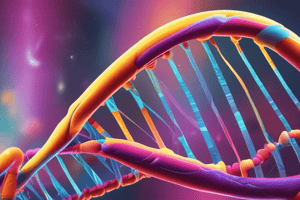Podcast
Questions and Answers
What is the primary function of genes within DNA?
What is the primary function of genes within DNA?
- To store energy for cellular processes
- To transport nutrients across membranes
- To protect cells from harmful substances
- To serve as blueprints for making proteins (correct)
Which component is unique to RNA and not found in DNA?
Which component is unique to RNA and not found in DNA?
- Adenine
- Uracil (correct)
- Deoxyribose
- Thymine
What structure do nitrogen bases form in DNA?
What structure do nitrogen bases form in DNA?
- Hydrogen bonds with strong covalent bonds
- A circular loop
- A solid core
- A twisted ladder shape (correct)
Which of the following correctly matches the complementary base pairing in DNA?
Which of the following correctly matches the complementary base pairing in DNA?
What type of sugar is found in RNA molecules?
What type of sugar is found in RNA molecules?
How many pairs of chromosomes do humans have?
How many pairs of chromosomes do humans have?
Which process involves copying DNA before cell division?
Which process involves copying DNA before cell division?
What part of the nucleotides makes up the backbone of DNA?
What part of the nucleotides makes up the backbone of DNA?
Which statement accurately describes the main function of DNA?
Which statement accurately describes the main function of DNA?
What is the correct pairing of nitrogen bases in RNA?
What is the correct pairing of nitrogen bases in RNA?
Which of the following correctly describes the structure of DNA?
Which of the following correctly describes the structure of DNA?
What are nucleotides primarily composed of?
What are nucleotides primarily composed of?
How does DNA replication ensure genetic consistency in cells?
How does DNA replication ensure genetic consistency in cells?
Which type of sugar is present in DNA?
Which type of sugar is present in DNA?
What role do hydrogen bonds play in DNA structure?
What role do hydrogen bonds play in DNA structure?
What characteristic differentiates DNA from RNA?
What characteristic differentiates DNA from RNA?
Flashcards are hidden until you start studying
Study Notes
Nucleic Acids
- The macromolecule that holds our genetic material is DNA (deoxyribonucleic acid).
- Contains sections of DNA called genes that serve as blueprints for making proteins.
- Genes are located at specific points on a chromosome.
- Proteins perform all cellular activity.
- DNA and RNA (ribonucleic acid) are the two types of nucleic acids.
Nucleotides
- The building blocks of nucleic acids are nucleotides.
- Nucleotides are made up of three parts:
- Sugar: Deoxyribose (DNA) or Ribose (RNA)
- Phosphate
- Nitrogen Base: Adenine, Guanine, Cytosine, Thymine (DNA only), Uracil (RNA only)
DNA Structure
- DNA is a double helix, resembling a twisted ladder.
- The sugar and phosphate molecules form the "sugar-phosphate backbone".
- Nitrogen bases bond in the middle with weak hydrogen bonds.
- All other bonds are strong covalent bonds.
DNA Base Pairing
- Nitrogen bases pair with their complementary base pair through hydrogen bonds:
- Adenine (A) bonds with Thymine (T).
- Cytosine (C) bonds with Guanine (G).
- These are called the "complementary base pairing rules."
RNA Structure
- RNA is a single strand of nucleotides with exposed bases.
- RNA bases bind with DNA bases:
- Adenine (A) binds with Uracil (U).
- Cytosine (C) binds with Guanine (G).
DNA vs. RNA
- DNA
- Nitrogen bases: A, T, C, G
- Sugar: Deoxyribose
- Shape: Double helix
- RNA
- Nitrogen bases: A, U, C, G
- Sugar: Ribose
- Shape: Single strand
Basics of Heredity
- Chromosomes are tightly coiled strands of DNA.
- Different organisms have varying numbers of chromosomes:
- Humans: 23 pairs (46 total)
- Dogs: 37 pairs (74 total)
- A gene is a section of DNA that codes for a protein.
- One chromosome can contain thousands of linked genes.
DNA Replication
- DNA replicates when a cell is ready to divide.
- The process of creating an identical copy of DNA is called DNA Replication.
- DNA DNA
- DNA replication happens in the nucleus during the S phase (Synthesis) of Interphase.
- DNA replication ensures that each new cell has the same DNA as the original cell.
Steps of DNA Replication
- First, DNA unzips.
- (To be continued)
Nucleic Acids
- The macromolecules that contain our genetic information
- Are made up of nucleotides
- There are two types: DNA and RNA
- DNA stores the instructions for making proteins
- Proteins carry out all cellular activity
- Genes are sections of DNA that contain the code for making a specific protein
Nucleotides
- The monomer of nucleic acids
- Have three parts:
- Sugar: deoxyribose (DNA) or ribose (RNA)
- Phosphate
- Nitrogen base: Adenine (A), Guanine (G), Cytosine (C), Thymine (T - DNA only), Uracil (U - RNA only)
DNA Structure
- A double helix structure, similar to a twisted ladder
- The "sugar-phosphate backbone" is formed by the sugar and phosphate groups
- The nitrogen bases bond in the middle using weak hydrogen bonds
- All other bonds in DNA are strong covalent bonds
- Nitrogen bases bond only to their complementary base pair:
- A bonds with T
- C bonds with G
- These are called the "complementary base pairing rules"
RNA Structure
- A single strand of nucleotides with exposed bases
- RNA bases can bind to DNA bases
- A bonds with U
- C bonds with G
DNA vs. RNA
- DNA:
- Contains the bases: A, T, C, G
- Contains the sugar deoxyribose
- Has a double helix shape
- RNA:
- Contains the bases: A, U, C, G
- Contains the sugar ribose
- Has a single strand shape
Basics of Heredity
- Chromosomes: Tightly coiled strands of DNA
- Genes: Sections of DNA that provide instructions for building a protein
- Organisms have different numbers of chromosomes:
- Humans have 23 pairs (46 total)
- Dogs have 37 pairs (74 total)
- One chromosome can contain thousands of linked genes
DNA Replication
- The process of copying DNA to make an identical copy
- Occurs during the S Phase (Synthesis) of Interphase
- Ensures that each new cell produced will have the same DNA as the original cell
- The process:
- The DNA molecule unzips
- Each original strand serves as a template for a new strand
- New nucleotides are added to each template strand by complementary base pairing
- The result is two identical DNA molecules
Studying That Suits You
Use AI to generate personalized quizzes and flashcards to suit your learning preferences.




